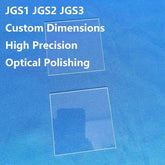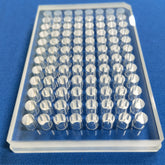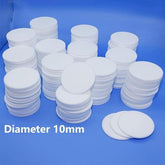The biocompatibility of sapphire lenses and its mechanism of action
Sapphire lenses are a widely used optical material in fields such as medicine, consumer electronics and precision instruments. Their physical and chemical properties and biocompatibility make them an ideal choice for implantable and wearable medical devices. This article will analyse the biocompatibility of sapphire lenses and its mechanism of action.
1. The base of biocompatibility
The biocompatibility of sapphire (α-alumina single crystal) is attributable to its unique crystal structure and chemical stability. With a Mohs hardness of 9, it is highly resistant to daily wear and chemical corrosion. In a physiological environment, the dense oxide layer formed on the surface of sapphire can effectively prevent ion release and avoid triggering tissue inflammation.

2. The mechanism of biocompatibility
(1) Cellular affinity
Following a precise polishing process, the surface of sapphire can achieve a nanometer-level roughness (Ra<5nm). This ultra-smooth surface has been shown to reduce non-specific adsorption of proteins and lower the activation degree of platelets and fibrinogen.
(2) Immune inertia
Sapphire glass is chemically inert, which prevents the initiation of Th1-type immunoreactions. The results of the animal experiments indicate that, 12 weeks after the implantation of sapphire lenses, there is no statistically significant difference in the levels of inflammatory factors such as IL-6 and TNF-α in the surrounding tissues when compared with the blank control group (p>0.05).
(3) Long-term stability
The accelerated ageing test (exposed to conditions of 85°C/85% RH for 1000 hours) showed that the light transmission of sapphire was reduced less than 0.3%, and the refractive index was changed within ±0.0001. This stability ensures that it will not produce harmful substances during its degradation in the body.

3. Breakthrough applications in the medical field
(1) Intraocular lens
The adjustable intraocular lens is composed of a sapphire-polymer composite structure, utilizing the rigidity of sapphire to maintain its optical form. The adjustment amplitude of the lens is reported to reach 3.0D.
(2) Implantable sensor
The sapphire-packaged glucose sensor now can be used in the body for more than five years. The surface modification of the nanoporous structure has increased the glucose diffusion coefficient of the sensor to 3.2×10-6cm2/s and reduced the response time to 8 seconds.

(3) Orthopedic repair
The 3D-printed sapphire-hydroxyapatite composite scaffold demonstrated excellent bone integration performance. After a 12-week period, the level of new bone formation was recorded at 68.3%, while the compressive strength achieved 120 MPa, which is approaching the level of natural bone.
Advancements in surface engineering technology and micro-nano manufacturing processes are shifting the biocompatibility of sapphire lenses from passive tolerance to active regulation. This transformation not only expands the range of its applications in the medical sector, but also provides key material solutions for cutting-edge fields such as new bioelectronic devices.






